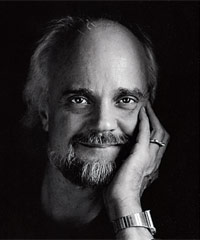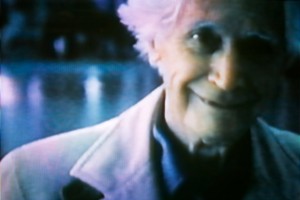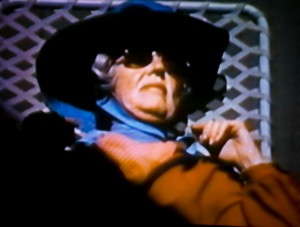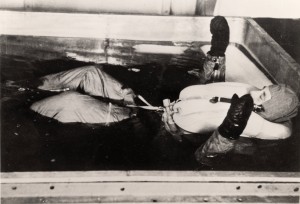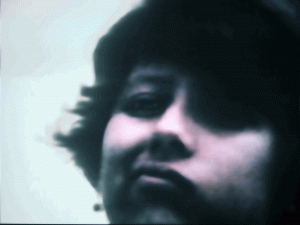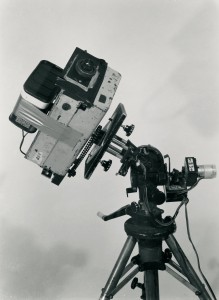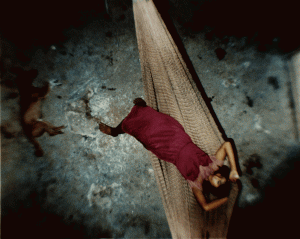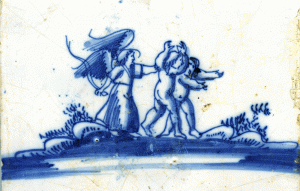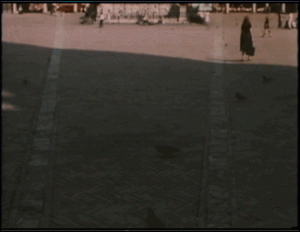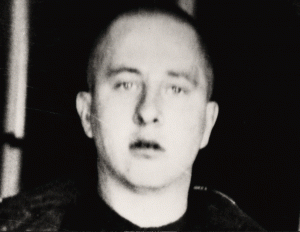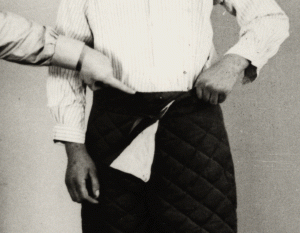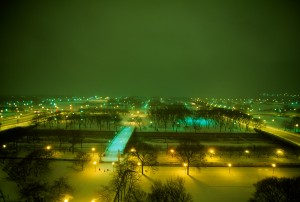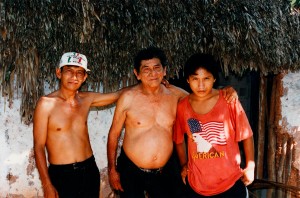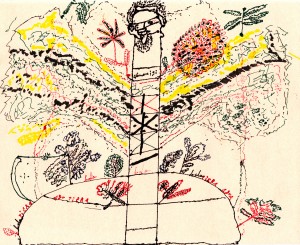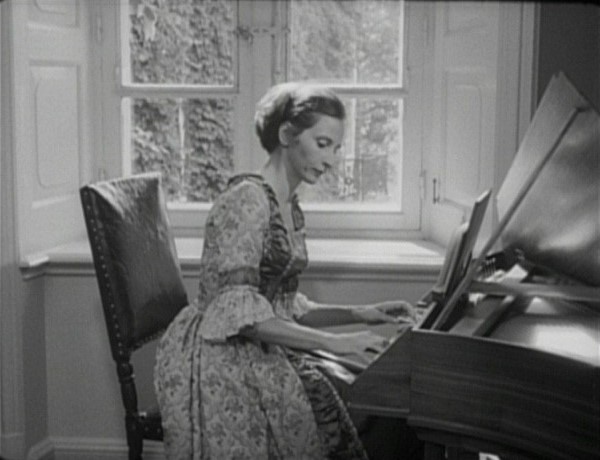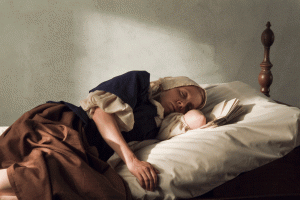From Film Quarterly, Fall 2009. Note: Peter Thompson’s complete work as a filmmaker, along with many extras, is available here. There is also a web site devoted to his work at chicagomediaworks.com — J.R.
It would hardly be an exaggeration to call Peter Thompson the best Chicago filmmaker you never heard of. His half a dozen films, four shorts and two features, span 28 years, and their continuities and discontinuities with one another seem equally important. Pertinent to all six films are diverse aspects of Thomson’s background: as a classical guitarist who studied with Andrès Segovia in Siena, as an undergraduate and graduate student in comparative literature (University of California, Irvine), as a onetime Navy photojournalist who teaches photography at Columbia College Chicago, and even as a first cousin of the special effects pioneer Douglas Trumbull.(Full disclosure: Thompson has been a friend for almost two decades — and a neighbor for roughly half that time — but it was my enthusiasm for his first two films that initially sparked our friendship.)
His shorts come in two pairs, each one a diptych. Two Portraits (1982, 28 minutes) is devoted to his parents and each portrait works with a minimalist expansion of limited footage juxtaposed with offscreen voices—those of Thompson and his late father in the first part, Anything Else, and those of his mother reading from her diaries in the second part, Shooting Scripts. Anything Else features stop-frame images of his father in an airport, accompanied by a multifaceted verbal portrait offered by his son, then outdoors and accompanied by a recording of his parents’ conversation shortly before his father’s death. Shooting Scripts shows us nearly motionless footage of his mother asleep in a garden chair around dusk while a long shadow gradually blacks her out — until she wakes at the end and speaks in synch sound, with the sounds of the garden behind her.
Universal Hotel (1986) and Universal Citizen (1986), each 28 minutes long, which overlap with one another more subtly, are personal essays, both narrated by Thompson (whose performative voice sharply reflects his musical background). In the first Thompson chronicles his research into hypothermia experiments by Dr. Sigmund Rascher at Dachau in 1942, in which he used a German ex-prostitute to rewarm a Polish prisoner of war who had been nearly frozen; Thompson uses photographs of the experiment culled from archives in six countries and recounts a dream set in what he calls the Universal Hotel. The second film is a multifaceted personal travelogue bringing us to a real Universal Hotel, in Guatemala, and to the same public square in Siena that appears at the beginning of Universal Hotel; at the center of this film are Thompson’s offscreen meetings with a Libyan Jew and former Dachau inmate who works as a smuggler in Guatemala and refuses to be photographed except at a distance.
Various kinds of reticence and indirection figure in all four shorts, which were released on a single video by Facets Video in 1987. Thompson’s notes on this video allude to his “father’s suicide,” although the single reference to this in Anything Else is so oblique that it’s easy to miss. Thompson’s narration comes in two parts. The first part concludes, “He was once expelled from college for drinking. He never drank again or took drugs until he did both on April 1 and again on April 3, 1979, 44 years after his expulsion.” The second part, heard just after the recording of his parents’ strained conversation, concludes, “His ashes, weighing 4 pounds 8 ounces, were dropped into the sea off Point Lobos, California. Two weeks after his death his wife announced her second marriage. He knew this man and had exchanged Christmas cards with him each year for 41 years. At Christmas time he [i.e., Thompson’s father] would say to his family, ‘Don’t bother with a present. I don’t need anything. I don’t need anything else.’” Thompson has described the main themes of Universal Hotel and Universal Citizen as “the emotional thawing of men by women, the struggle to disengage remembrance from historical anonymity, and unrecoverable loss,” though nothing in Universal Hotel indicates that the “thawing” it’s concerned with is emotional and not simply physical.
El movimiento (2003, 116 minutes), shot over almost a decade in Yucatan, is described by Thompson on his website (www.chicagomediaworks.com) as “a collaboration between a shaman [Don Chabo], an anthropologist [William F. Hanks], and a filmmaker. It is built on a deep and specialized knowledge ofMayan-Franciscan religious practices, Spanish colonial history, economic and political pressures impacting Yucatec Mayans at the end of the 20th century, the performance aspects of ritual, the uses of participatory camera, the multiple identities of a film subject, and the hopes, dramatic possibilities, and limits of intercultural understanding.” To illustrate part of what’s meant by “participatory camera” (as well as the relevance of Thompson’s relationship to Douglas Trumbull), Thompson had special cameras designed (by Chicagoan Jno Cook) “to reflect both classical Mayan notions of cyclical time and the cyclical patterns of daily life within [Don Chabo’s] household,” including “a 360ºrotating motorized slit-scan camera to take a 100-foot long continuous horizontal image with no frame lines on 35mm movie film” and “a combination 180º tilting/360º rotating motorized tripod”.
The recently completed Lowlands (2009, 51 minutes), “exploring the effects of war upon domestic and creative life,” focuses largely on Catherina Bolnes, the wife and widow of Johannes Vermeer (1632-1675). It’s the first film of Thompson that excludes autobiography, apart from the film’s framing device — Thompson’s recollection of asking his mother about two 17th century Dutch tiles, seen at the very beginning and then at the very end of the film, whose two painted stories embody the main themes to be explored. Among the elements the film draws on, apart from Vermeer’s paintings, are etchings by other Dutch artists “on the effects of Louis XIV’s policy of rape warfare” and contemporary documentary footage accompanying Thompson’s offscreen accounts of its effects in 1672, archival b/w photographs and b/wfilm footage taken in Delft during World War II, a deposition before the International Criminal tribunal for the Former Yugoslavia in the Hague during the trial of a Bosnian Serb in 1996, and a newly commissioned, contemporary musical score in Dutch by Joseph Cancellaro to a libretto in Dutch by Thompson, based on an imagined dream of Catherine Bolnes, staged as a masque near the end of the film.
All six films are troubled and troubling meditations on history and epic efforts of research and retrieval, concerned simultaneously with the shape of entire lives and with fleeting experiences. It’s also significant that dreams are often given as much attention as objective facts. In El Movimiento, Thompson and Hanks recount their own dreams, and Don Chabo uses drawings and reenactments to convey visions and experiences that led him to become a shaman in his mid-20s, after his family died of starvation during a locust plague. All three characters seem to periodically exchange roles, adding to the slippage between objective and subjective realities. We first encounter Don Chabo via his voice as he looks through a camera’s viewfinder for the first time. He exclaims to Hanks, “Hey, I see a little guy in there!” and Hanks responds, “That’s me!” But Don Chabo is a quick learner. After performing a healing ceremony, he speaks a word that he’s now learned from Thompson, “Cut!”, and at that moment is clearly the director. Much later we learn that Hanks’s role in healing a seriously ill Don Chabo led Hanks to resume the apprenticeship in healing that he’d abandoned.
Thompson also emerges clearly as a character in Universal Citizen, which alludes to his wife and their adopted Puerto Rican daughter in Chicago, but the things we aren’t told seem just as important as the information we get. Indeed, in spite of their confessional aspects, Thompson’s first five films are dominated and even structured by these absences—what might be called their secrets. We never discover the reason for his interest in filming the smuggler, nor do we learn why he’s fascinated with Rascher’s experiments, apart from the extratextual allusion to “emotional thawing”.
Writing several years ago about Universal Hotel, Fred Camper noted that Thompson accompanies the still photos of the German medical experiments “with a narration so mechanical that it implies no degree of emoting could capture SS-perpetrated horrors,” and it’s easy to see how he could conclude that. In Lowlands, the disparity between the atrocities recounted by Thompson and his flat, uninflected delivery is even more pronounced. For me his methodology evokes Robert Bresson insofar as he’s suppressing overt emotion to make room for other kinds of emotional expressiveness, such as rhythm and the meaning of the words. I doubt it’s a coincidence that the least accessible of his films is Shooting Scripts, the only film in which his voice isn’t heard. The first thing we’re told in El Movimiento, quoted from a 1562 chronicle, is that the name “Yucatan” — where practically all of this film was shot — derives from the inability of the Spanish explorers and Mayan merchants to understand each other’s language. When the Spaniards asked, “What is this place called?” the Mayans responded, “We do not understand your language,” the short version of which is “Yucatan.” As we hear this we see successive 360-degree pans around 360-degree still photographs of the Yucatan village where Don Chabo lives (the end of the last photo shows Thompson facing the camera) — implying a somewhat less skeptical view of the capacity of language, in this case film language, to communicate. This simultaneous display of faith and lack of faith are characteristic of the film as a whole and make an interesting comparison with the dialectic implied by the beginning of Universal Hotel and the end of Universal Citizen, both of which use the same footage of a woman walking diagonally across a public square in Siena, away from the camera and out of the frame. Over the beginning of Universal Hotel Thompson says offscreen, “1981. I see everything from a distance from my window in the Universal Hotel,” and then we hear phone calls pertaining to his research in which he speaks in English and Italian, then in French, and finally in German and English; we don’t hear anything about what the woman is doing or why. Over the end of Universal Citizen he explains that in 1982 he bet his wife that she couldn’t walk to the white fountain in the Siena square with her eyes shut. “‘Oh, that’s simple,’ she said, ‘It’s right in front of me,'” he continues, while we see the same woman retreating — and straying far from the fountain. (Whether this footage was shot in 1981 or 1982 is only one minor mystery among countless others.)
What follows is an edited email exchange between myself and Thompson conducted in May 2009.
JONATHAN ROSENBAUM: Fiction seems to play a steadily increasing role in your work, especially in the ways that you use your findings — a process culminating in the musical masque near the end of Lowlands, but also apparent in the ways that you use archival 20th century documentary footage and even contemporary footage to illustrate various things that happened in the 17th century.
PETER THOMPSON: What a question guaranteed to make a documentarian squirm! Let me back into it by means of a delightful one-sentence parable by Mr. Kafka: “The world is uncommonly various; this can be verified at any time by taking a handful of world and looking at it closely.” This sentence speaks of wonder, curiosity, intention, proof, judgment, humor, care, understatement, graciousness, naming, personal connection, commitment, paradox, and a child’s unclouded seeing. These seem like reasonable tools with which to look at any “handful” of historical world — not always the easiest of worlds to hold, and full of shards, blanks, and various kinds of messiness.
I’m in the messy business of translating the worlds I see, along with my internal one, into form. To translate is to betray.In spite of that wriggle-room for inaccuracy, I often experience shame vis-à-vis my documentary subjects.I am aware of what was simplified, reduced, or left out. On a bad day, I see my films as crime scenes. On a good day, I experience pleasure thinking about them. This see-sawing is not unique to me; it seems inherent in the documentary endeavor.
So I choose documentary subjects with reticence. Universal Hotel, for example, looks closely at the small world of eleven photographs and two drawings from a medical experiment in Dachau involving a German ex-prostitute and a Polish prisoner of war. The nature of this experiment could be easily sensationalized and I have no clear credentials with which to handle it: I am not German, nor Polish, nor a doctor; I was born two years after the event; and so on. I approached it only after it surfaced in my dreams, 14 years after being introduced to it. I understood those dreams as permission to give voice to it. I understood them as a passport into an uncertain world, one that could be revoked at any time.
It requires empathy to begin to look closely at a handful of world, and you must monitor that empathy. This process is not governed by any fixed laws of logic. You’re correct, Jonathan, when you characterize some results of the process as creating “fiction”. The next questions to ask are, “What kind?” and “Why?” There’s a marvelous little essay by Harry Berger, Jr., that I just re-read and find useful. Berger explores the tendency of renaissance consciousness to create a “heterocosm” — literally, a “different world” in which to experiment. Renaissance writers sometimes leave a given world and generate an alternative one in which the claims of the world left behind are acknowledged or settled. That alternative world is both disjunctive and make-believe. Its separateness and limits are signaled by some original framing device showing it to be contrary to established fact. After being securely framed in that way, it then admits within its imaginary world factual elements in order for them to be amplified. The musical masque in Lowlands functions in this way.
I create “safe harbors” — recognizable, explicit spaces in which my subjective experience can be acknowledged. The most overt example of this is the musical masque with which Lowlands culminates. It’s a radical genre-break from the documentary, and quite over the top in its subjectivity. But each element — including the musical carnival theme within the documentary upon which the composed music in the masque are variations — is generated from objective elements within the documentary and tied to those elements by analogy, or, as you say, “rhyme”.
JR: The issue of fiction is posed most strikingly by one especially daring “rhyme”. At one point you show a Vermeer painting of Catherina and say, “This painting will later be titled by others, Woman Weighing Gold, but they imagine gold where there is none. The scales hold nothing but light.” About ten minutes later, Witness L, during his 1996 deposition about the war crimes committed by himself and another Bosnian Serb, says, “[Dusko] Tadic ordered [the two raped girls] to beat each other over some gold” — gold that he goes on to explain was imaginary.
PT: I included the deposition because it echoes the objective history of rape warfare through which Vermeer lived in his final years, and also because it echoes the mis-titling of Vermeer’s painting. It functions to import unexpressed 17th century emotion forward into the 20th century by analogy. So too, do the b/w photographs and b/w film footage taken during and after the Second World War that appear throughout the documentary. They function as if they were shot in the 17th century. Their actions are analogous to actions in the 17th century for which no visual record exists.
JR: For me, this points to a certain literary aspect of your films — the way you like to use metaphors, similes, allegories, and so on, such as that funny bit about walking towards the fountain in the Siena square at the end of Universal Citizen.
PT: True. Most documentarians present information in a hierarchical manner with highly regulated connections between elements. One image for this structure is a tree. I have come to greatly appreciate films that embody not only the “tree” but also the rhizome, with its surface connections, rhymes, and echoes. These two images are beautifully delineated by Gilles Deleuze and Felix Guattari — but not being an academic, I’m sure that I’m misusing their notions for my own purposes.
The rhizome seems to parallel the ways in which psychological meaning develops. Mary Dougherty, my wife and a Jungian psychoanalyst, speaks about her work as making not one interpretation to link the disparate events of a life, but rather as the ongoing process of re-mapping the territory by continually linking disparate experiences. As a documentarian, that feels pretty right to me. I often experience the historical world less as a handful of objective “facts” than as a stream of analogies and rhymes unearthed and amplified while walking the dog.
JR: In fact, dreams are recounted in most of your films, starting with Universal Hotel, and it’s sometimes hard to determine whether these dreams are part of the research or part of the fiction. Are the ones attributed to you actual dreams, hypothetical dreams, or some combination of the two?
PT: Documentaries, whether involving a contemporary or historical person, drag the filmmaker’s being into the process. I enfold whatever I’ve been gifted with into it. These gifts can include dreams separated from historical consciousness by the flimsiest of veils and of relevance to the “handful of world” that I’m studying. I tend to have a few relevant dreams during the research and shooting stages (but never during the editing stage), and those included in my films are real. This holds true for two dreams by one of my collaborators on El movimiento, William F. Hanks (professor and chair, Department of Anthropology, University of California, Berkeley). Will tells one of those dreams on camera just after waking from it — one that embodies the complicated relationship between shaman, anthropologist, and filmmaker. During editing, I asked to include it and Will was brave enough to permit it. During the editing, I place dreams not caught on camera within their own safe harbor so viewers will not be confused by a shift from objective to subjective.
There are two additional dreams presented in El movimiento. Both occurred in Chicago. One is narrated by Will, one by me. The viewer hears them while experiencing the passage of time in Chicago between annual visits to Yucatan: photographs of Grant Park taken from a high-angle fixed camera making one exposure per day for one year. That structure is different from other structures in the film and feels like a safe harbor for subjectivity. El movimiento was shot over an eight-year period.During the second year’s filming, I brought drawing paper and colored markers to Don Chabo because of the visions he had described during the first year’s filming. He created wonderfully concrete drawings of his visions, his dreams, and I included them in the film.They bring inner and outer together.
JR: One of the ways that you combine “inner” and “outer” in Lowlands is the way that you draw more and more attention to all the things that Vermeer’s paintings exclude, such as war, disease, and, above all, financial strife, which finally overtakes Catherina Bolnes’ life after her husband’s death and thereby depletes all the domestic furnishings that we know from the paintings and that we tend to take for granted when we look at them. This has a polemical effect, and I wonder how much of this was intentional. At the outset, Lowlands reminded me of Straub-Huillet’s Chronicle of Anna Magdalena Bach by offering a kind of materialist account of the production of art, but by the end I feel that in some ways this method and even Vermeer’s art are thrown into question. By drawing our attention to everything that Vermeer chose to leave out of his paintings, you make us uncomfortably aware of everything that had to be suppressed in order for his art to function — a suppression that his widow eventually had to pay for. What are (or were) you thoughts about this? Was this a conclusion that you had at the outset, or did it derive from your research?
PT: Before Columbia College Chicago hired me to head up an experimental media workshop, I was gallery director of the Friends of Photography. There, I had the privilege of working with three of the “Group f/64” photographers — Imogen Cunningham, Brett Weston, and Ansel Adams. They made sharply seen, clearly defined images.I was now far from California, and far from the aesthetic that I valued as a balance to my own experimental one. I grew increasingly hungry for that balance, and found myself drawn to the sharply seen, clearly defined paintings of Johannes Vermeer. They piqued my interest in his life. I remember reading the inventory of household goods made after his death and noticing a pattern: children’s beds, children’s chairs, and bedpans were common to every room in his house. Reseeing Vermeer’s paintings with this awareness, I could now “see” the exclusion of all untidy, uncomfy, untoward domestic life; I could “see” the exclusion of his wife’s fifteen pregnancies; I could“hear” past the “silence” of his privileged domestic moments. At this time, Mary and I were raising four children in a small apartment.Even with only six of us — not seventeen — silence was not in great abundance within our four walls. I thought, “What a feat! Where, Mr. Vermeer, might you be putting your noises, beds, chairs and bedpans?”
From wonder at his domestic exclusions, I began to wonder about others that might lie beyond Vermeer’s four walls. This led to readings on the history of the Netherlands during Vermeer’s lifetime, including wars visited upon his country by England, Spain and France. A total surprise. These, too, Vermeer rigorously excluded. I thought, “How utterly amazing! Where are you putting the war visited upon your country during the last four years of your life? Where is the collapse of the art market, and the economy, and your inability to feed your family? Where is the sudden death of your only patron, Pieter van Ruijven, who commissioned half your total output? Where is Louis XIV’s policy of rape warfare, the policy that drove Dutch refugees into Delft to live on the streets below the windows you paint?”
Social, psychological and domestic issues — all rigorously excluded. Vermeer also seems to have excluded himself, personally, from crucial domestic moments. He was absent from a legal deposition at which all other adults in the family — his wife, mother-in-law, maid and two pigment grinders — testified against his wife’s brother for attacking her with an iron pin affixed to a stick when Catharina was “pregnant to the last degree”. I then read two wonderful articles by Harry Berger, Jr., and Lawrence Weschler, each of which explores the notion of Vermeer’s avoided issues from different perspectives. In Weschler’s New Yorker essay, “Inventing Peace”, he writes that Vermeer so overtly excluded war from his paintings that they paradoxically embody the very notion of “peace”. Weschler saw an early edit of Lowlands. His feedback on this issue was invaluable. As I continued to edit the documentary parts of the film, Vermeer’s wife steadily emerged out of her “exclusion” to become the hero of it — its actual, true subject — as she was the actual, true hero of her family. Upon her husband’s death in 1675, it was Catharina who was left with no income and ten minor children; it was she who fought to save Vermeer’s paintings from creditors by declaring bankruptcy. My gradual awareness of her importance emerged over 182 versions of the script (that’s one of the compensations of having a day job — you can better afford to support slow realizations). By the time I was ready to shoot the masque, Catharina was solidly in the driver’s seat.

